Two New Ions: ASUS AT3N7A-I and ASRock Ion 330
by Anand Lal Shimpi on August 28, 2009 12:00 AM EST- Posted in
- Motherboards
The first companies to support non-Intel products are those that have the weakest relationships with Intel. How Intel is able to ensure this is the crux of the AMD v. Intel antitrust suit, but that’s not the point of today’s story.
NVIDIA’s Ion platform, at least when first introduced, combined Intel’s Atom CPU with NVIDIA’s GeForce 9300/9400M integrated graphics chipset. This offered better performance and modern features compared to Intel’s 945G chipset, what Intel was bundling with Atom. Intel still sold the CPUs but it lost the chipset sale and got upstaged by NVIDIA. Intel doesn’t like being upstaged by anyone.
Intel’s partners are very cautious when supporting a product like Ion. They don’t want to appear too eager and thus Intel’s closest partners wait to see if a product like Ion succeeds before attempting to jump on the bandwagon.
Zotac built the first mini-ITX Ion motherboard. While Zotac builds several Intel motherboards, they are hardly considered a tier 1 motherboard manufacturer. Zotac doesn’t get preferential treatment by Intel and thus Zotac doesn’t have to worry about ruffling any feathers by releasing an Ion motherboard.
I can’t tell you how well the Zotac Ion has sold, but reading our review and user experiences with the board I can tell you that customers are pleased. It’s a good product and it fills a niche that Intel currently has no answer to. I’m not even sure if Pine Trail will address that market either.
ASUS was Intel’s launch partner for Atom. The first place you found the Atom processor was in ASUS’ Eee PC and Eee Box. The rest of the OEMs followed. It’s no surprise that ASUS didn’t build an Ion motherboard or an Ion netbook for that matter.
ASUS tested the waters with its value manufacturing brand earlier this year. ASRock put out an Ion system based on the Intel Atom 330 processor; note the use of the word system. The ASRock Ion differed from the Zotac Ion motherboard in that it was a barebones system complete with mini-ITX chassis, external power supply, 2GB of RAM, slim optical drive and 320GB hard drive. All you needed to add was an OS.
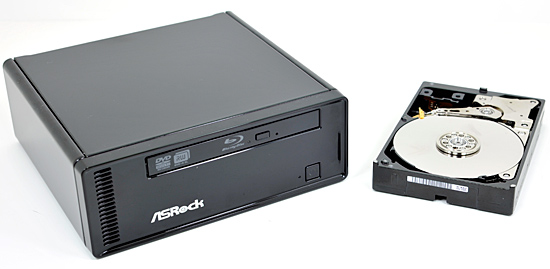
The ASRock Ion 330 (left) vs. a 3.5" HDD (right). We're not too far away from having P4-class PCs in the space of a hard drive.
The whole package sets you back $379.99 (ASRock does charge a slight premium for building the thing).
A couple of weeks ago we got word that the second mini-ITX Ion motherboard was coming our way. The manufacturer? ASUS. Ballsy.
Unlike the ASRock and Zotac Ion solutions, ASUS gave its Ion board a real and unnecessarily complex name. This is the AT3N7A-I:

Also gone is the North American favorite “Rock Solid, Heart Touching” phrase on the box. Instead we’re given two new slogans: Inspiring Innovation, Persistent Perfection (hooray for alliteration) and Perfectly suit your digital lifestyle.
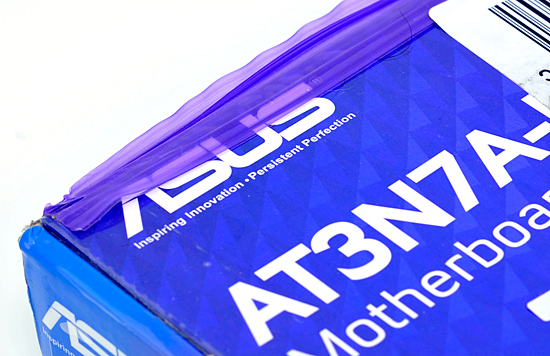
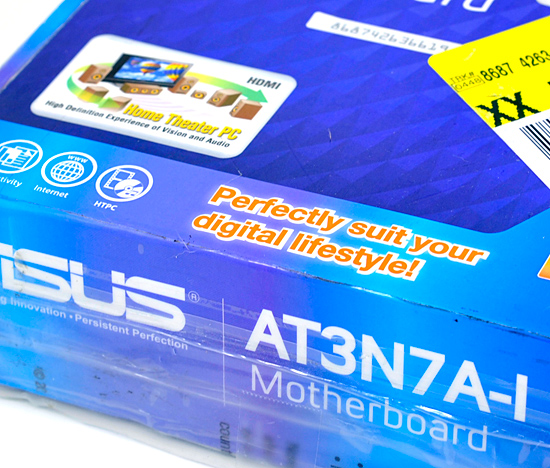
A Closer Look at the ASUS AT3N7A-I
ASUS’ Ion board doesn’t come with a power supply, it instead has a 24-pin ATX power supply connector and a 4-pin 12V connector for CPU power. The ASUS Ion is eerily similar to the Zotac board but with poorer color choices.
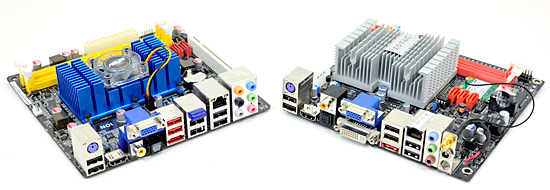
Zotac’s board has on-board WiFi, while ASUS’ board has on-board Bluetooth.

ASUS (left) vs. Zotac (right)
ASUS adds a ton more USB ports on the rear of the AT3N7A-I. You get a total of 8 USB ports (+2 more via an internal header), a single PS2 port, HDMI out, VGA out, coax/optical out, eSATA, Ethernet and the standard array of six 1/8” jacks for analog audio out.

On the board itself there are three SATA ports, like the Zotac board, but ASUS also adds a standard 32-bit PCI slot (not PCIe).
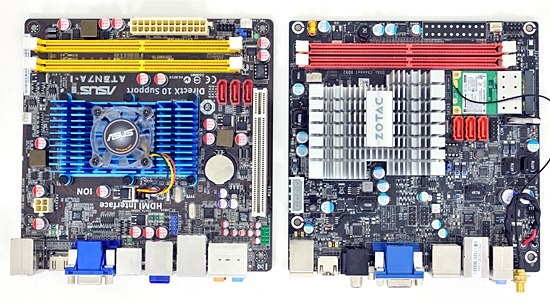
ASUS (left) vs. Zotac (right)
Two DIMM slots round out the package.










61 Comments
View All Comments
cghebert - Friday, August 28, 2009 - link
Anand,While SSDs obviously offer a speed increase, you can't store that many movies on them. And, if you have a small ITX case, there might not be room for two drives. Are the ION systems fast enough to play HD movies over ethernet, or would the two drives need to be in the same case?
Thanks for the review btw!
GeorgeH - Friday, August 28, 2009 - link
Right now you can get Zotac's LGA775 Mini-ITX GF9300 for 119 AR. Couple that with a $50 E1500, and you've got a $169 system that will destroy these ION platforms for the exact same price. Similar options exist on the AMD side as well (think GF8200 + X2 240 Regor for ~$160.)Given that those options exist, a comparison with Atom would be awesome, especially one covering noise, power consumption, and case choices - i.e. could you build an LGA775 Mini-ITX in a similar form factor as the ASRock with comparable acoustics, or do you really need the ultra-low power consumption and TDP of an Atom CPU?
eversteegt - Tuesday, November 3, 2009 - link
Great, but are you sure the GF 9300 on that board has the same core with the same features (like playing Full HD 1080p video completely hardware-accelerated in Linux) as the GF9300 core on the ION platform? ;)Pandamonium - Friday, August 28, 2009 - link
That Zotac board doesn't support wake on USB quite yet, as far as I can tell. That's a pretty huge deal breaker for HTPC duty.Personally, I want something only powerful enough to handle streaming HD. If Adobe/nVidia get their act together and offload Flash scaling to the GPU, the Atom gets my vote for the reduced TDP. For a system that will be sitting in an enclosed TV stand (glass door style), a low TDP is absolutely necessary.
GeorgeH - Saturday, August 29, 2009 - link
If the Zotac board doesn't work for you, you can pick up an Intel G45 board for ~$5-10 less. As to the TDP, the idle power of a 5050e/780G system can be as low as 35-40W, or about the same as the Asus ION board - which leads me to believe that they're also producing comparable amounts of heat at idle or when doing IGP accelerated video playback.Obviously the 5050e is going to be more efficient than the examples I listed (which I couldn't find reputable and relevant numbers for) and will consume much more power than the Atom under full CPU load, but that's not the point. The point is that I'm not quite convinced that ION is necessary or even the best option unless you're going with ultra-slim designs such as the Aspire Revo.
cghebert - Friday, August 28, 2009 - link
That's an excellent point. I actually just built a micro-ATX Athlon X2+Radeon 4550 based system as my HTPC because I wanted a system that could play Hulu and other streaming internet videos, something that the ION would limit.Plus, one beef I have about most ITX cases (at least that don't come with a DC adapter for their power supply) is that they are TALL. Taller than a nice micro-ATX case, which fits much better amongst my HT gear.
One case that I didn't look at that is worth mention for the ION is this one http://www.mini-box.com/M350-universal-mini-itx-en...">http://www.mini-box.com/M350-universal-mini-itx-en...
from the same people that make the PICO psu.
I'd also like to see a comparison between ION systems and low power ITX systems built with Intel or AMD desktop chips.
TA152H - Friday, August 28, 2009 - link
Intel did a nice job with the processor, but we're stuck with either getting the miserable 945, or buying something from a crap company (NVIDIA) that is at least somewhat modern.What a terrible choice. I'd love to own an Atom based file server, but what kind of choice is this? I'm not stupid enough to buy NVIDIA, but then, what kind of choice is the grotesquely obsolete 945 chipset?
It has taken Intel far too long to come out with a reasonable solution to this problem. You could overlook it for a few months, or even half a year, but it's gone on far too long. It's a pity ATI didn't enter this market. You'd have nice performance, and it wouldn't be so frightening to buy a product from them.
Anand, why put the Pentium 4 in the power tests? They kind of came out of nowhere, and, actually used less power than I thought they would. You really seem to have a weird fascination with the Netburst processors; probably because they were so bad, they are interesting. I will say this though, if they had been built on 45nm, with the much better power characteristics of this process, they'd probably hit 6 GHz in their sleep. Meaning, they'd perform roughly like the 2.0 GHz Core 2 :-P.
eversteegt - Tuesday, November 3, 2009 - link
Why this "steep" comment about NVIDIA being crap?For Linux users (like me), NVIDIA is the ONLY quality option to play back hardware-accelerated video. AMD does not even get close to build stable graphics drivers for Linux, let alone hardware-accelerated HD video. I think NVIDIA ION is the only platforum that gives the Atom a right to exist....
strikeback03 - Monday, August 31, 2009 - link
Intel does have a more modern chipset for Atom (the US15) but almost no one is using it. Whether this is due to cost or another stupid Intel limitation I do not know.bh192012 - Friday, August 28, 2009 - link
What was WOW like after you OC CPU and GPU? Also, if someone someday decided to actually cool these things with something bigger than a 40mm fan, can you hit 2.2 ghz etc.